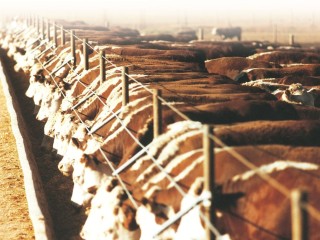 The sums on feeding 100-day grainfed cattle remain deeply in the red, Beef Central’s regular feedlot breakeven calculation carried out yesterday suggests.
The sums on feeding 100-day grainfed cattle remain deeply in the red, Beef Central’s regular feedlot breakeven calculation carried out yesterday suggests.
Results have deteriorated by another $5 a head compared with the last assessment on July 13, due mainly to rising feeder cattle prices driven by limited supplies being offered.
An analysis based on yesterday’s spot market for inputs suggested a breakeven figure in the high 360s, dressed weight, for 100-day grainfed steers ex-Darling Downs, going on feed today and closing-out on November 16.
That’s up 3c/kg on a similar analysis done three weeks ago. Finished ration price remains the same as for the last breakeven calculation at $255/t (that’s based on ‘aggressive’ pricing, and some custom feeders may in fact charge more than that, one credible source said).
Feeder steer prices have risen around 5c/kg liveweight over the past three weeks to 180c/kg, worth about $20/head. Total production cost was calculated at a neat $1300, a rise of about 1.7pc from $1278 on July 13, including feeder steer purchase plus typical feeding program, and a 1pc mortality rate.
Another influence on the outcome is the over-the-hooks forward market price for mid-November, which, while still difficult to define due to the lack of liquidity among grainfed processors, has been raised from 350c to 355c/kg. That’s still a long way from the high 370s seen in early June's breakeven calculation.
The 5c/kg rise is a reflection of the traditional annual ‘high-point’ seen in meatworks cattle around this time each year, as well as recognition of the stand-off currently occurring between processors and grainfed ox vendors over price.
The spot market for 100-day grainfeds today is around the 330c/kg mark, up a little from 325c/kg three weeks ago. That’s due mostly to a slow return to higher processing throughput after a period of very low kills, caused by an excess of meat in the supply chain and flat international demand driven by the A$ and global financial fears.
All this means today’s proposition for close-out in 100 days’ time is about 15c/kg dressed weight below breakeven, worth about negative $46 a head. While slightly worse than the same calculation in mid-July, it’s nowhere near as bad as a negative $89 figure calculated in late June. Figures close to break-even have not been seen in Beef Central’s calculation since before Easter.
Beef Central’s calculation is based on assumptions including a 356kg dressed weight, average daily gain of 2kg, and a feed conversion ratio of 7.5:1 (as fed).
One or more variables have to shift in order for figures to move closer to profitability again for 100-day cattle. Depending on meat supply commitments, if processors hold their line on current offer prices, there might be some decline seen in feeder cattle prices, one analyst suggested today.
To go closer to breakeven, forward grain-finished cattle price must go up 15c/kg, or feeder cattle back by 10c/kg to make sense. Already, the reading of the overall cattle market in southern Queensland this week is that slaughter cattle in general have risen a few cents/kg, while feeder cattle have shown an easing trend. Part of that can be explained by the effects of winter starting to impact on restocker and feeder selling patterns.
Within those considerations are a couple of positives, however. Firstly, the A$ fell US2c today, to US107.80c, as concerns started to ease over the US debt crisis. If the lower currency persists, it will remove a little of the competitive disadvantage Australian export processors are currently experiencing.
Secondly, lotfeeders are heading into a period where cattle on feed performance should lift quite significantly. Average daily gains, conversions and respiratory disease morbidity performance should all improve, judging on normal seasonal cycles. That could be worth up to $30 a head on typical custom-fed cattle.
Feedlot survey looms
As discussed three weeks ago, profitability forecast figures like these do not auger well for the quarterly feedlot activity survey for the period ending June 30, which should be released any day.
Compared with the solid outlook just three months ago, there is a lot more bearish sentiment evident around in Australian lotfeeding circles currently, and no immediate signs of change in market variables.
One saving grace could be that the timing of the survey (figures represent occupancy as at June 30) might fail to capture the worst of the recent profit declines and slowdown in placements. If the survey was to be conducted at the end of July, instead of the end of June, the state of the grainfed industry could have looked a lot worse, a contact told Beef Central.
Today’s NLRS Eastern Young Cattle Indicator closed at 380.25c. The NLRS feeder steer indicator closed at 200.8c, down 1c on yesterday.
- • Beef Central's regular 100-day grainfed breakeven scenario based on a representative standard set of production variables, ex Darling Downs. It is important to note, however, that variations can exist across production models (feed conversion, daily gain, mortality, morbidity, carcase specification); from feedlot to feedlot; and between mobs of cattle. For a more specific performance forecast on a given mob of cattle, contact your preferred custom feeder.
